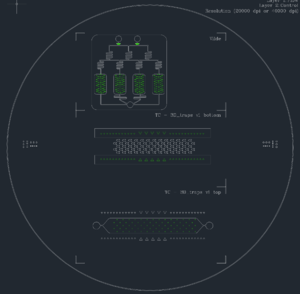Difference between revisions of "Microfluidics"
From mn.fysikk.laglivlab
Dagkd@uio.no (talk | contribs) |
Dagkd@uio.no (talk | contribs) (→Designing Microfluidic masks) |
||
| Line 2: | Line 2: | ||
* Stanford microfluidics foundry has a good guide for [https://web.stanford.edu/group/foundry/Designing%20Your%20Own%20Device.html designing your own device]. That includes a guide to use AutoCAD. | * Stanford microfluidics foundry has a good guide for [https://web.stanford.edu/group/foundry/Designing%20Your%20Own%20Device.html designing your own device]. That includes a guide to use AutoCAD. | ||
* AutoCAD (a program from Autodesk) is available free. | * AutoCAD (a program from Autodesk) is available free. | ||
| + | [[File:Skjermbilde 2021-04-20 kl. 15.33.04.png|left|thumb|Some microfluidic circuit designs for a 3" wafer]] | ||
** [[Skolelisenser]] | ** [[Skolelisenser]] | ||
** [[Elev og lærerlisenser]] | ** [[Elev og lærerlisenser]] | ||
| − | |||
* You can use [https://www.klayout.de/ Klayout] but we have more support for using Autocad. | * You can use [https://www.klayout.de/ Klayout] but we have more support for using Autocad. | ||
* [https://www.mn.uio.no/fysikk/forskning/prosjekter/laglivlab/dokumenter/new-mask-template.dwg Mask template] for placing your designs | * [https://www.mn.uio.no/fysikk/forskning/prosjekter/laglivlab/dokumenter/new-mask-template.dwg Mask template] for placing your designs | ||
Revision as of 12:02, 3 April 2022
Contents
Designing Microfluidic masks
- Stanford microfluidics foundry has a good guide for designing your own device. That includes a guide to use AutoCAD.
- AutoCAD (a program from Autodesk) is available free.
- You can use Klayout but we have more support for using Autocad.
- Mask template for placing your designs
- This guide for designing masks has some important tips
- All fluid pathways have to be inside one or more closed contour(s)
- The outer contour should be drawn in one layer (Give it a name like "Flow")
- Any obstacles inside this outer contour must be drawn in another layer. Give it a name like "Flow inner polygons")
- Displaying your design as PDF or otherwise is not straight forward because the resolution needed. You get a fair impression using CloudConvert which is much better than AutoCads own pdf export.
- Example of a design where white lines (in screen shot below, black lines in PDF) are contours containing flow and green lines are inner polygons. Here is a PDF version of the file and the DWG file.
- Rounding corners on a region
- Command EXPLODE makes region into lines
- Command JOIN joins lines into polylines
- Command FILLET, downarrow to get options RADIUS and POLYLINE
Photolithography
PDMS casting
- PDMS preparation
- Bring cup with PDMS close to wafer in Petri dish
- Pour slowly and avoid introducing air bubbles
- Remove air bubbles by puncturing them
- Fill petri dish to 5-10 mm above wafer surface
Assembling the chip =
- Clean glass slide with IP and N2
- Punch holes for fluid inlets
- For 1/16" tubes use OD?? punch
- For thin teflon tube use OD?? punch
- Place both PDMS and glass slide with clean sides up on glass plate in plasma cleaner
- Follow instructions for Plasma treatment
